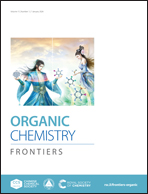Iron-catalyzed asymmetric Csp3–H/Csp3–H coupling: improving the chirality induction by mechanochemical liquid-assisted grinding†
Abstract
The iron-catalyzed asymmetric oxidative coupling is a challenging transformation that is typically restricted to naphthol substrates (Csp2–H) with carefully designed chiral ligands. Herein, we established a mechanochemical protocol for iron-catalyzed asymmetric Csp3–H/Csp3–H coupling between glycines and β-ketoesters. By using size-tunable liquid additives via non-covalent bond interactions with simply designed chiral salen ligands and substrates under mechanochemical treatment, it is possible to improve the asymmetric induction and offer a variety of structurally diverse α-amino acid derivatives in high enantiopurity. Mechanistic studies revealed that the iminium ion derived from acid-assisted aerobic oxidation of glycine ester was the key intermediate of the reaction, and the liquid additive t-BuOH acted both as a stabilizer for the iminium ion via N–H⋯O interaction and as an assistant for enantio-control. Moreover, a safer, cleaner, and more energy-conserving route via mechanochemically accelerated aging was first disclosed for this asymmetric Csp3–H/Csp3–H coupling reaction.



 Please wait while we load your content...
Please wait while we load your content...